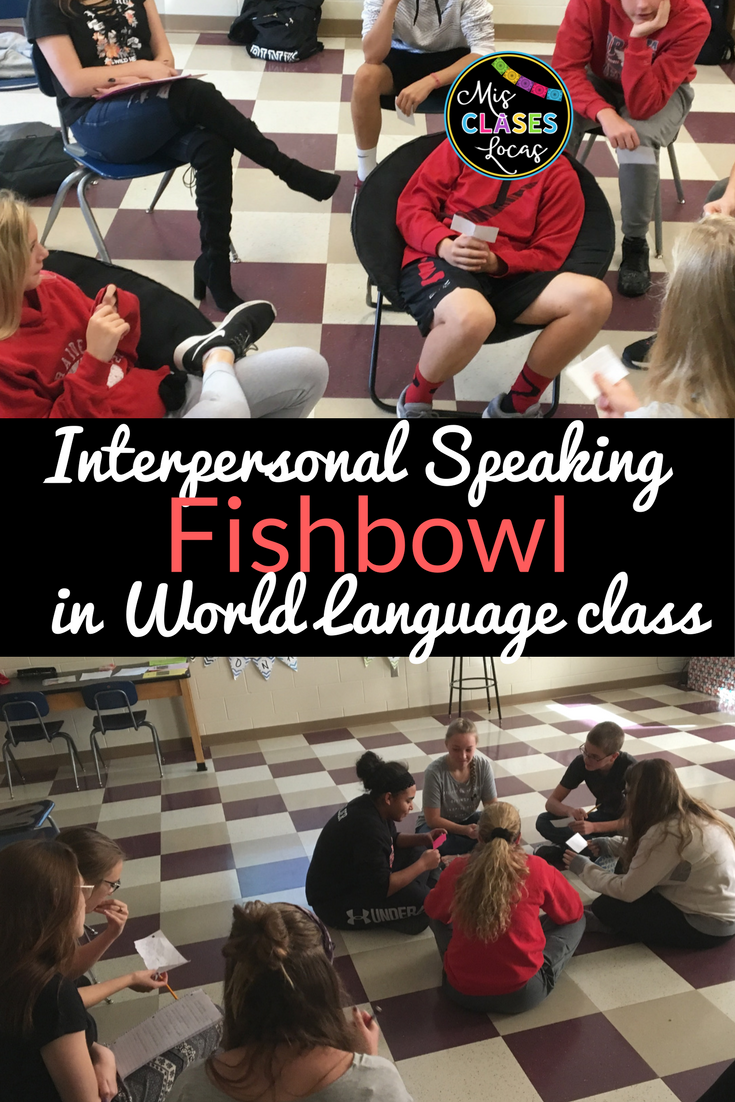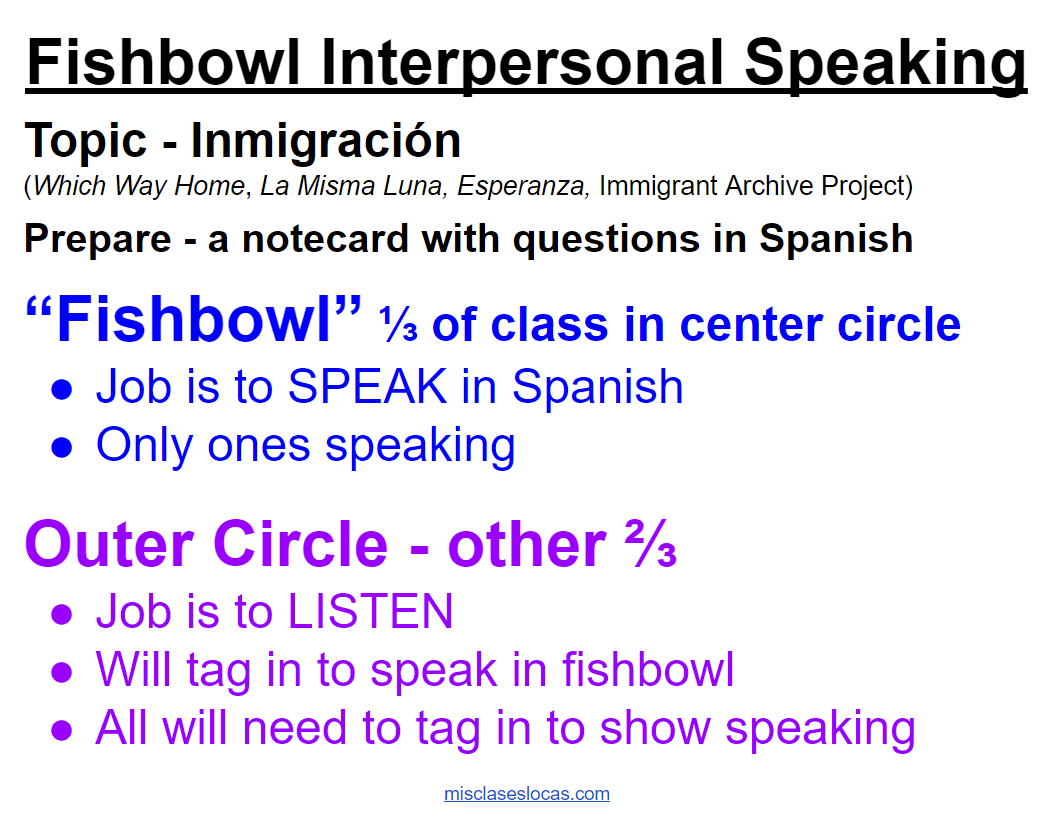Inside: Fishbowl Speaking Activity in Spanish Class. Fishbowl Interpersonal Speaking Spanish class assessment and activity.

Fishbowl Speaking Activity
Since I am a #deptof1 and the only World Language teacher in my district, I get to be with the English teachers for our PLC time at school. This is actually amazing, since we all teach using novels, there are so many ways we can collaborate and share. I have learned a lot about teaching with novels from the great English teachers at my school.
At one of our recent meetings, the awesome junior high English teacher talked about a technique she used in her class for interpersonal speaking called a “fishbowl.” I decided this was something I would like to try out and then did some research.
What is a Fishbowl Activity in Class?
A group of students in the center “fishbowl” speak on a certain topic, and the rest of the students on the outside listen. Students rotate in, so everyone gets a chance to talk.
From my online findings, there were multiple teacher posts about how to implement such a discussion, but there were not any that were World Language specific. I like the instructions in this post and the image in this post as a starting point. Here is how I implemented an interpersonal Fishbowl discussion in Spanish 2.
How to do a Fishbowl Activity
Pick an open-ended topic to discuss
My overall goal was for students to talk to each other about immigration relating to our unit including the novel Esperanza and the films Which Way Home and La Misma Luna. It is actually helpful to have a topic that has a little bit of debate involved, to make it more interesting. At the same time, it is important to establish a class culture of respect and understanding.
(On another note, this particular class has done an Awesome job discussing this sensitive topic this year. As opposed to two years ago, when I would have not attempted a fishbowl discussion for this unit since I was scolded by both parents and students for “pushing my political views” by bringing up immigration).
Have students prepare to discuss in the Fishbowl
Students were told to prepare a note card of open-ended questions to ask in SPANISH. We spent some time working on questions the day before and they were to come to class the day of the fishbowl ready to talk. I even gave them time at the start of class, to make sure they felt confident and had something prepared.
We worked on writing open ended questions, so instead of specific things like “What is the name of Esperanza’s husband,” a better question is “compare the immigration for Esperanza and Carlitos (in La Misma Luna).” It helped me realize we need to keep up the skill of creating questions.
Some students were not as prepared as I would have liked them to be. In the future, I would have students submit questions in advance, so we could compile a master backup list of great questions. You could also use Spanish Novel Conversation Cards
Set up “Fishbowl”
I was very open with the students that we were trying something new together and I was not sure myself how it would go. I decided to have 1/3 of the class in the inner circle in the fishbowl and the other 2/3 on the outside. (Another option is to do half and half, with each person evaluating a specific partner. I chose a 1/3, since I wanted to make sure it was a focused discussion too many extra people).
With my deskless room, this was quite easy to physically set up. One class moved the comfy chairs to make a small inner circle, and the regular semi circle of chairs was the outer circle. The other class was so ready to get started, they plopped right down on the floor to create the fishbowl.
The expectations below were projected on the board. I had them in English, so everyone was very clear what their job was. Since it was my first time our “tag in” was very informal and if someone wanted in the conversation, they just placed a hand on the shoulder of who they would replace. Usually, once one new person went in, a whole new group would join in.

Enjoy the conversation in the Fishbowl
While the fishbowl went on I just sat at my desk and listened. A few times I intervened if there was an obvious miscommunication, such as when someone brought up a question that they created with the help of a translator. I think that having students submit questions in advance would help alleviate this problem.
I did have the expectation that a question could not be repeated, so everyone had to listen the whole time as well, even if they were not in the fishbowl. Towards the end, it was evident the outer circle was not paying as much attention to the middle as they should, since they were trying to come up with more questions. Having some ready-to-go extra questions typed up, and cut into strips would help out with this.
I really loved when a student had something to say on a topic and was on the outside. It was great to see them tag in to get to speak in Spanish. I just wish I could get that kind of engagement all the time!
Reflection on Fishbowl Speaking Activity
I was amazed that we spent about thirty minutes completing this activity completely in Spanish. I just let them go as long as they could. Even though many were basic novice-level questions, they were using the language to talk about something real and build confidence. They were very proud of themselves and how much Spanish everyone used.
I was a proud mama bear at how even those students who are not big supporters of immigration, discussed how they have compassion for children and refugees in certain situations. To me, building this empathy for others is so important, and I was very pleased with how positive the whole discussion was.
On the management side for me, completing this activity in the future, I need a better system of accountability. It would be helpful to have simple tally marks or check boxes for students to self and/or peer evaluate how many times each person asks a question, responds, adds a supporting detail, or helps drive the conversation. This would help students realize if they are dominating the conversation, and to try to encourage them to specifically ask the opinions of those who do not volunteer answers as easily.
Overall, I am glad I tried something new and at the end both sections asked to do a fishbowl again!
Other Interpersonal Speaking in Spanish Class
- If you are looking for more ideas, check out 10 awesome speaking activities.
- Find Someone Who Spanish Interpersonal Speaking
- Spanish Question Cards for Interpersonal
- Café y Conversación guest post from Jen Ries
- Interpersonal Communication Skills
- Novice Interpersonal Speaking Assessments
- Quick Tip: Rotating Partner Conversations – a no prep way to get your students speaking Spanish
Allison Wienhold of Mis Clases Locas has a decade of experience as a #deptof1 secondary Spanish teacher in Iowa. She enjoys creating curricula using novels, films, and music. Allison provides professional development to World Language teachers, including being the keynote speaker at MALT and Comprehensible Iowa, and workshop presenter at dozens of state & regional organizations, school districts, AEAs, and virtual conferences.

This is great! We call these Socratic circles at our school! I plan on doing the same. My co-worker has a rubric system for this. I hope to get it soon and would be happy to share! Have you done literacy circles before? Thanks for your help today! 🙂
If you could email me it, that would be awesome!
I have just found this blog. I am very interested in this, especially for Spanish III. would you email me.this rubric. Thank you.
Excellent post! We'll be trying one soon. My 1s are starting Capibara and my 2s just started BB vs Yucatan. I'm planning on giving my students tokens (poker chips would work) to "spend" when we do our first Socratic Seminar. The English department at my school has students 1)ask a question 2)comment on someone else's question 3)ask a follow up question. The outer circle coaches their inner circle partners.
I like the idea of having the coaches!
Kim Huegerich shared an accountability tool that she uses for this type of activity with us at a CI workshop at our AEA last week. It seemed simple yet effective.
Good to know! I will have to ask her!
Hello. I want to do this and I think this is a great idea. Can you provide an example of an open ended question you used for immigration? Or any topic?
A question that can not be answered with a specific answer.
Compare the immigration experience of Esperanza and Carlos (in La misma luna).
What did you learn about immigration?
How did you feel reading the book?
I am loving this idea and plan to use it with my Spanish 3 students while discussing the same novel. Did you ever find a rubric that you were happy with? I have a few that I have used for interpersonal communication but I would be interested to see how a fishbowl-type discussion rubric could be different!
I just used an interpersonal rubric. I know some teachers have assigned partners and tally how many times their group asks or answers a question